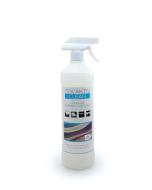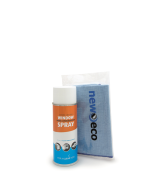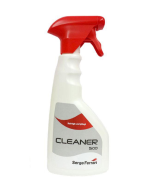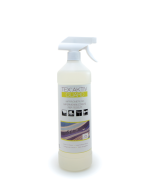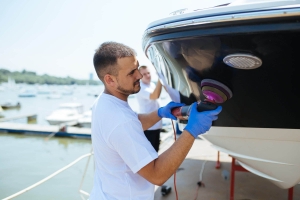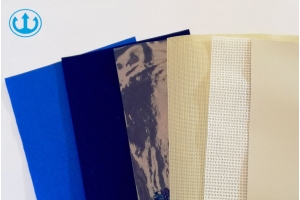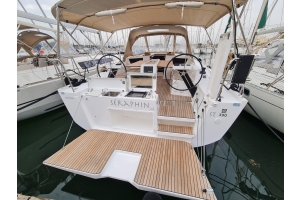SPRING CLEANING ON A BOAT
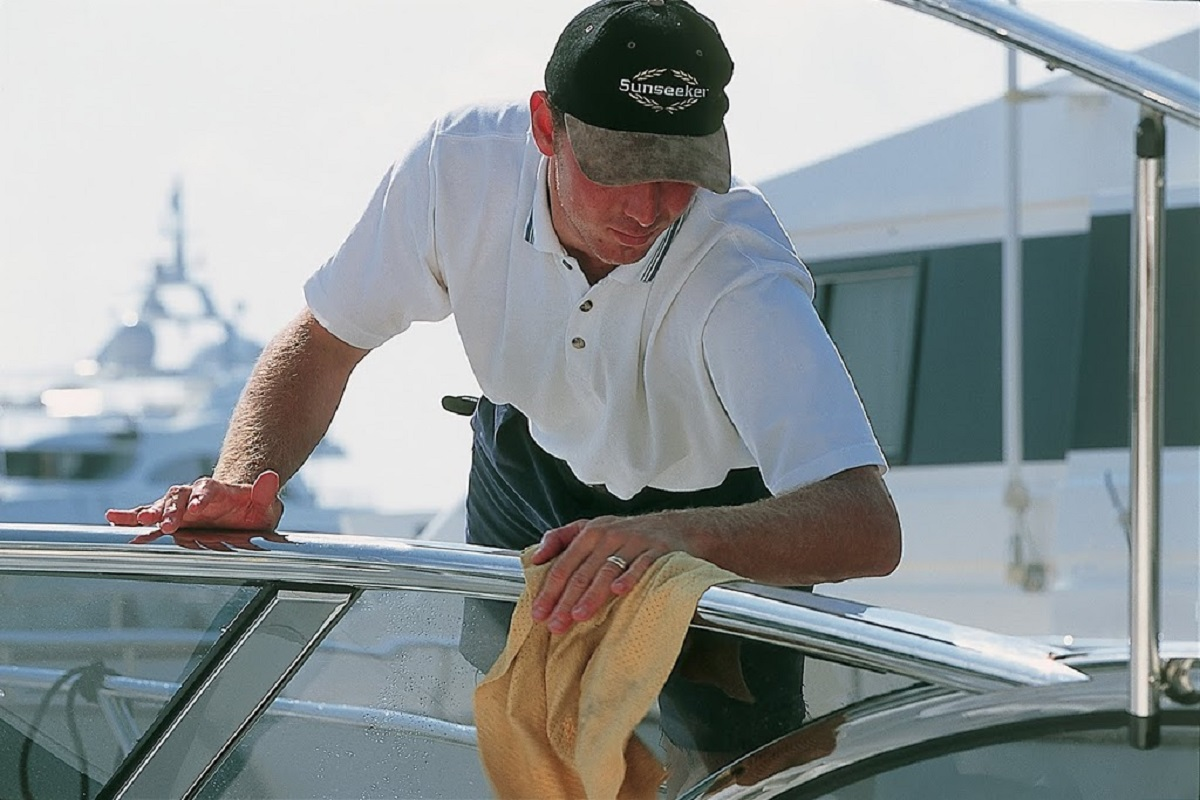
It's spring and back in the boat, but first let's make it shine!
The first days of spring instil an irresistible desire to get back on the water with your boat. Before leaving the dock, however, it is a good idea to do a general cleaning of all components, spaces and equipment on board. Here is how to proceed.
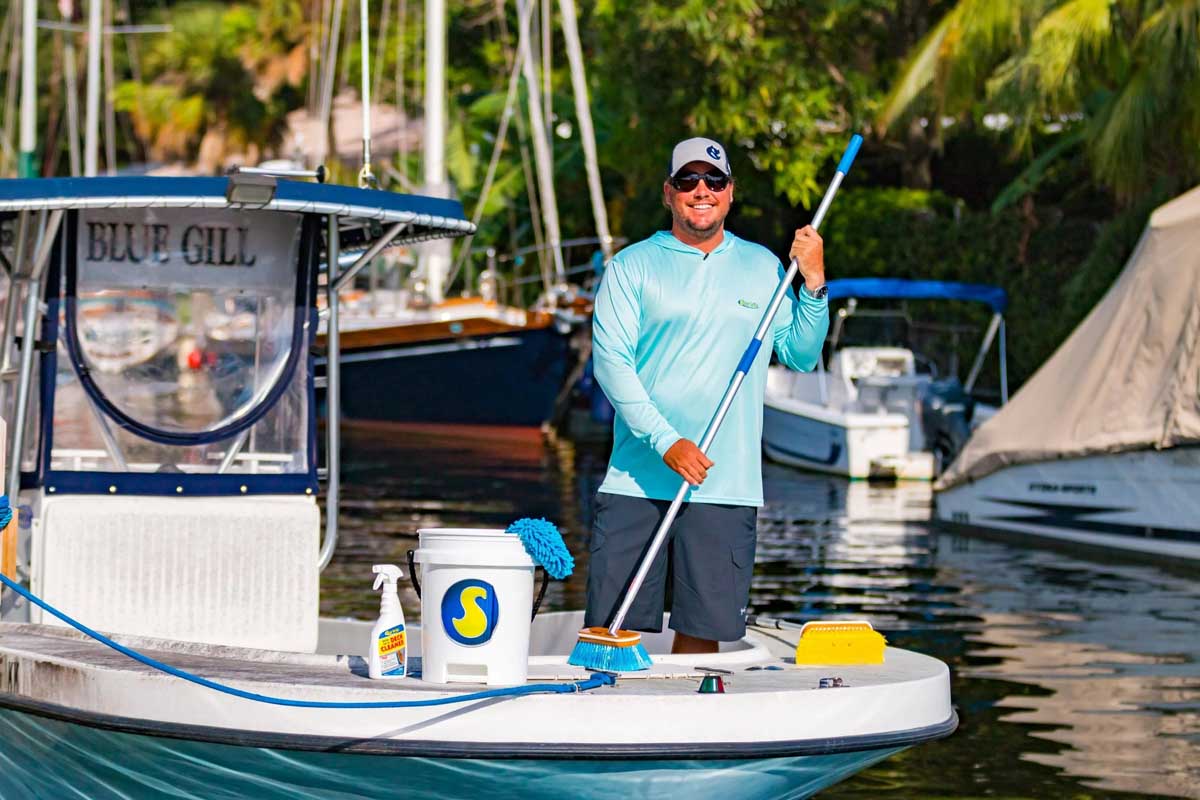
With the arrival of fine weather, the desire to sail, go on cruises and weekend getaways and, why not, perhaps take part in some flotilla trips with friends along the coast or exploring the islands, returns.
Before letting go of the moorings, however, it is good to take care of the boat and its equipment. A sort of good 'wake-up call' after the long break of the winter months.
The most important operation, whether it is a sailing cabin cruiser, a motorised open or a dinghy, is a general cleaning of all components and spaces outside and inside the hull. This is also a valuable opportunity to carry out the necessary checks and checks for any malfunctions to all on-board systems, including the rigging, engine and propeller, as well as all exterior and interior spaces.
In this comprehensive guide to spring cleaning we review all the components of a sailboat, but it can be a good starting point for any vessel or craft. We explain in detail how to clean every piece of equipment and space on board, the tools and materials to use and the correct procedure for the job.
It can be a lot of work, but taking advantage of the first sunny days it becomes a great way to re-establish a perfect connection with your boat, which will then be ready for beautiful new sailings.
Fibreglass hull
Pleasure boats are often built of fibreglass, a solid and durable material that is not, however, maintenance-free. Which starts with effective cleaning.
The parts of the hull that need to be cleaned concern the topsides of the boat, i.e. everything above the waterline: bow nose, sides, transom.
The living work, in fact, i.e. the immersed part of the boat, is covered with antifouling paint that serves to protect it from the formation of algae, dog's teeth, etc. This antifouling paint acts on its own and should not be tarnished.
Just to give the hull a quick clean, you can use a long-stemmed brush to manoeuvre on board a tender attached to the boat.
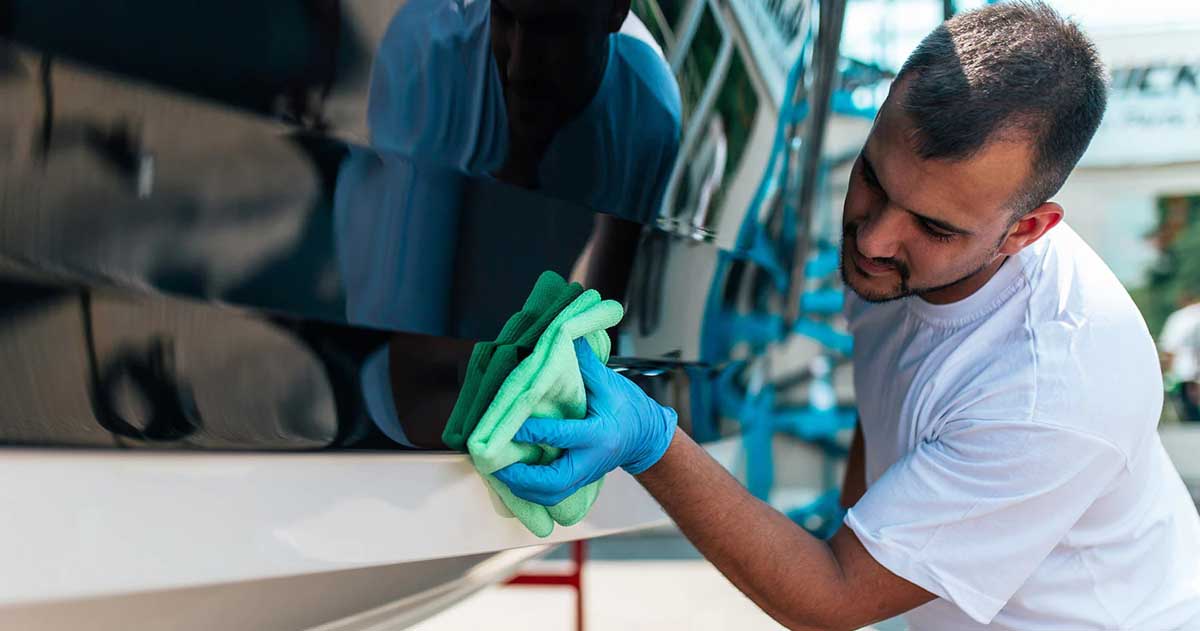
Gelcoat
In GRP boats, the last outer layer that covers the hull is the gelcoat, a polyester resin that protects the lay-up from water infiltration.
Being shiny and glossy, this resin also has an aesthetic function, but to last it needs care. Sea salt, in fact, together with sunlight, 'cooks' the gelcoat, making its surface opaque, porous and unsightly.
To clean gelcoat, in addition to fresh water, you can use a non-aggressive detergent in not very high concentrations.
To remove grease, wax and fuel stains or to conceal small scratches, it is necessary to intervene with 'polish', a slightly abrasive liquid that restores shine and removes roughness. An alternative are regenerating products that should be applied on small areas and with medium-hard bristle brushes.
As a final protective layer, Teflon-based products can be applied to protect the hull from the sun's rays.
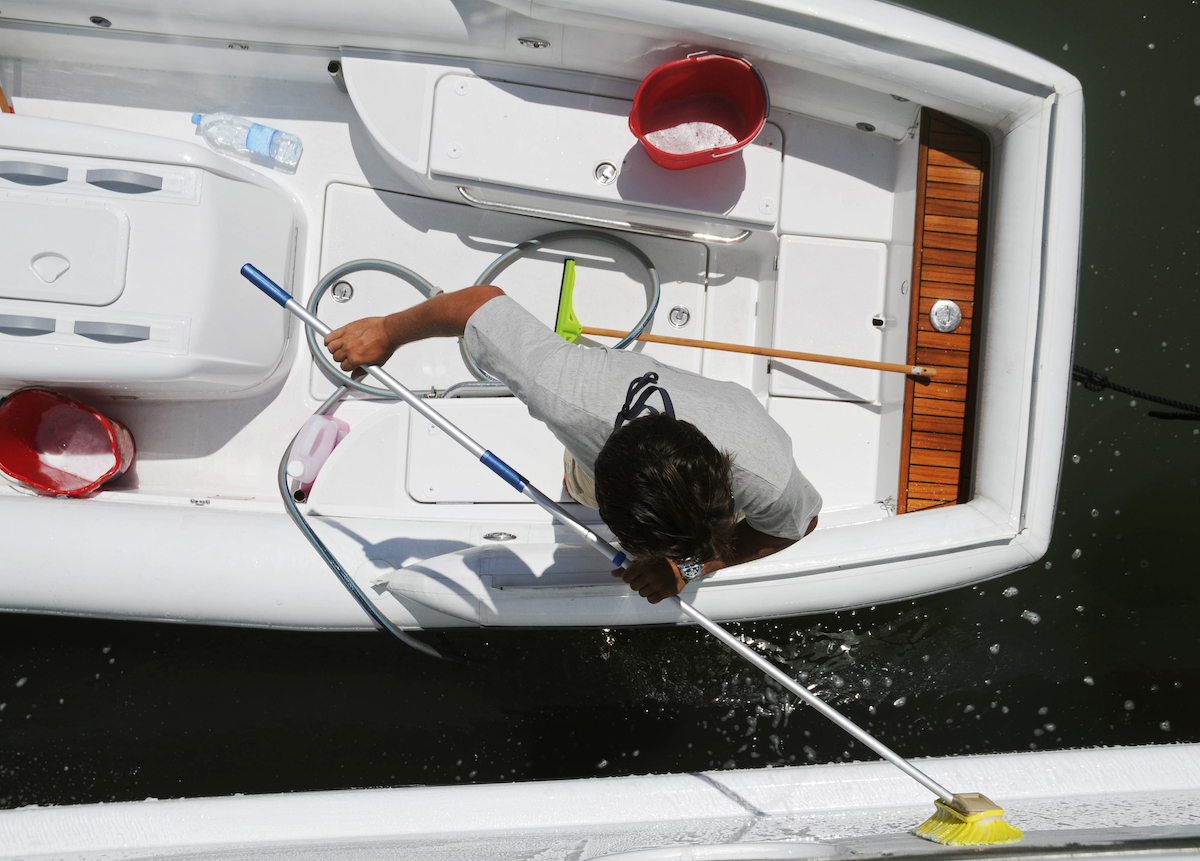
Deck equipment
On deck, it is best to take care of the 'dirty' jobs first: oiling the mechanical parts (winches, shackles, pulleys, trolleys, etc.), emptying the lockers, and only then washing and brushing the deck.
Trolleys, mainsail track, rails and blocks need a thorough washing to remove salt and dirt.
To remove the patina of oxide, scale and corrosion on steel equipment, simply spray with Crc.
For aluminium equipment (mast, boom, vang, tangons, hatches), simply rinse them with fresh water and a detergent.
A final coat of polish protects cleaned metal with a silicone-based film or waterproof wax.
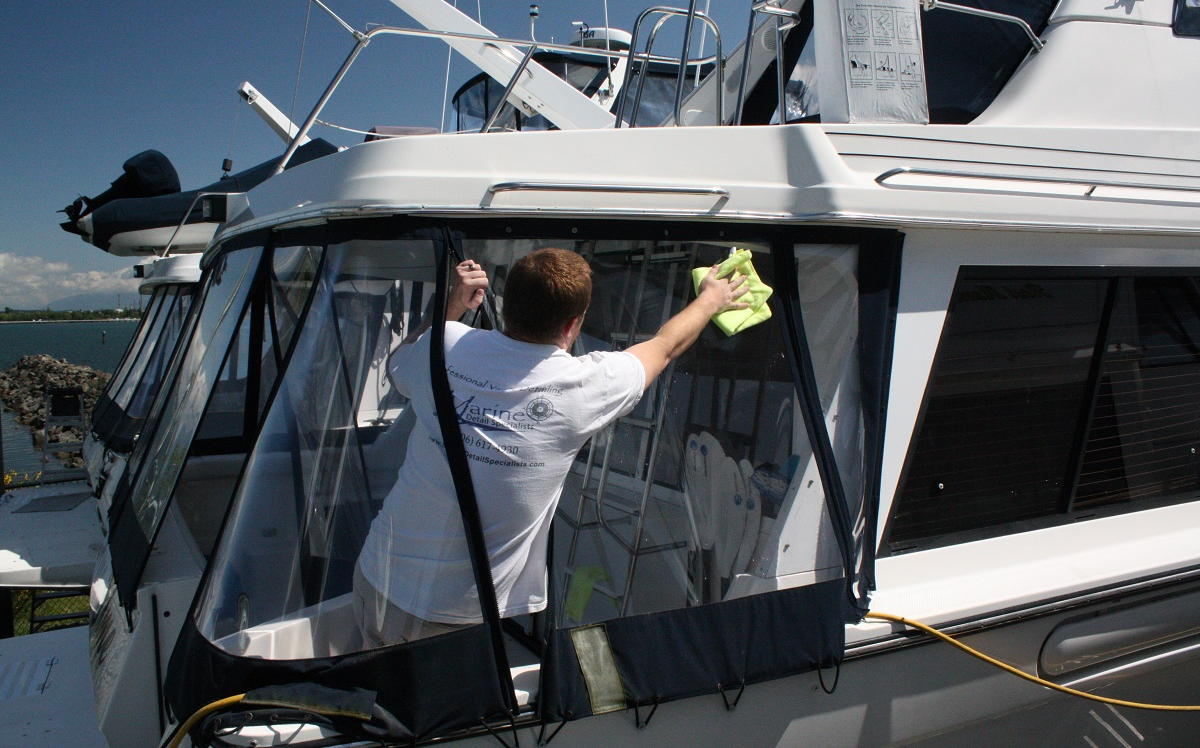
Furling, rigging and winch
The furling also deserves a good cleaning, using fresh water and a detergent with which to act on the drum, the extruder and the halyard joint, removing dirt and salt.
If the metal rigging is spiroidal, i.e. made up of steel strands, it has grooves in which saltiness, dirt and metal slag can be deposited, which could cause corrosion and breakage. If the rigging is instead made of rod, it has a smooth surface that is less prone to these phenomena.
At least once a year in both cases, it is a good idea to thoroughly clean these metal rigging and polish them.
For the winches, it is necessary to protect them from the salt and dust that can create encrustations in the internal parts, to the point of blocking the metal gears. In addition to thoroughly cleaning the bell and external parts, they must be disassembled and each piece cleaned with a brush and naphtha.
After drying, the moving parts can be protected with water-repellent marine grease (except for the pawls, which should be lubricated with light, high-penetration oils), while the fixed parts can be sprayed with anti-corrosion sprays.
Mast, rigging and stays
Even for the mast, cleaning is the first step of good maintenance.
When it is not lying on the ground on stands, the best way to clean a mast is to soap it and wash it with the help of a bansigo.
Once it is dry, starting from the masthead, you can begin the analysis of all the parts, from the masts to the windex with their respective seals, going down first along the extruded mast, then along the shrouds and stays, checking the sliding of the pulleys, shackles and snap hooks.
Attention should be paid to all riveted parts, as well as to contact points between steel and aluminium surfaces, cotter pins and spreader ends.
If everything is in perfect shape, proceed to lubricate all moving parts (pulleys, carriages on the mainsail rail, etc.) using a product such as Crc.
Remember to spray a protective film of water repellent on the electrical contacts at the masthead as well.
Fibreglass or teak deck
Salt, stains, traces of dirt and grease can soil the deck.
Again, a rough sponge, a cloth or a medium-hard bristle brush accompanied by a biodegradable detergent diluted in fresh water is sufficient for cleaning.
Soft water and specific products (detergents, polishes, revitalisers) can be used for dirty, dulled and faded plastic and rubber parts such as seals, headlights, frames.
Teak deserves a special mention. This precious wood, which often covers the deck and outer handrails, turns a light silver-grey colour over time.
It should be washed vigorously, but without scuffing or wearing away the surface, including the rubber joints between the strips.
To clean it, simply brush it, after wetting it with fresh water or sea water if clean and a neutral detergent: it is necessary to work orthogonally to the wood fibre so as not to hollow out the pulp.
If you want to restore the teak to its original colour, you can intervene with specific oils and waxes.
Sails
The durability of sails also depends on how much and how they are cleaned.
Cleaning from salt is essential because this, combined with the action of ultraviolet rays, tends to stiffen and corrode the sail fibres. Sails should be washed with lukewarm water and mild detergent, rubbing them with a sponge or soft brush in the dirtiest places and rinsing.
For stains, rust stains should be removed by soaking them in a solution of oxalic acid.
With mildew stains, bleach can be used and rinsed immediately because it tends to yellow if exposed to the sun.
For tar stains, sun oil can be used if fresh, then degrease with trichloroethylene.
Finally, glue stains can be removed with a little acetone.
To dry the sails, the best thing would be to raise them by going out for a short sail.
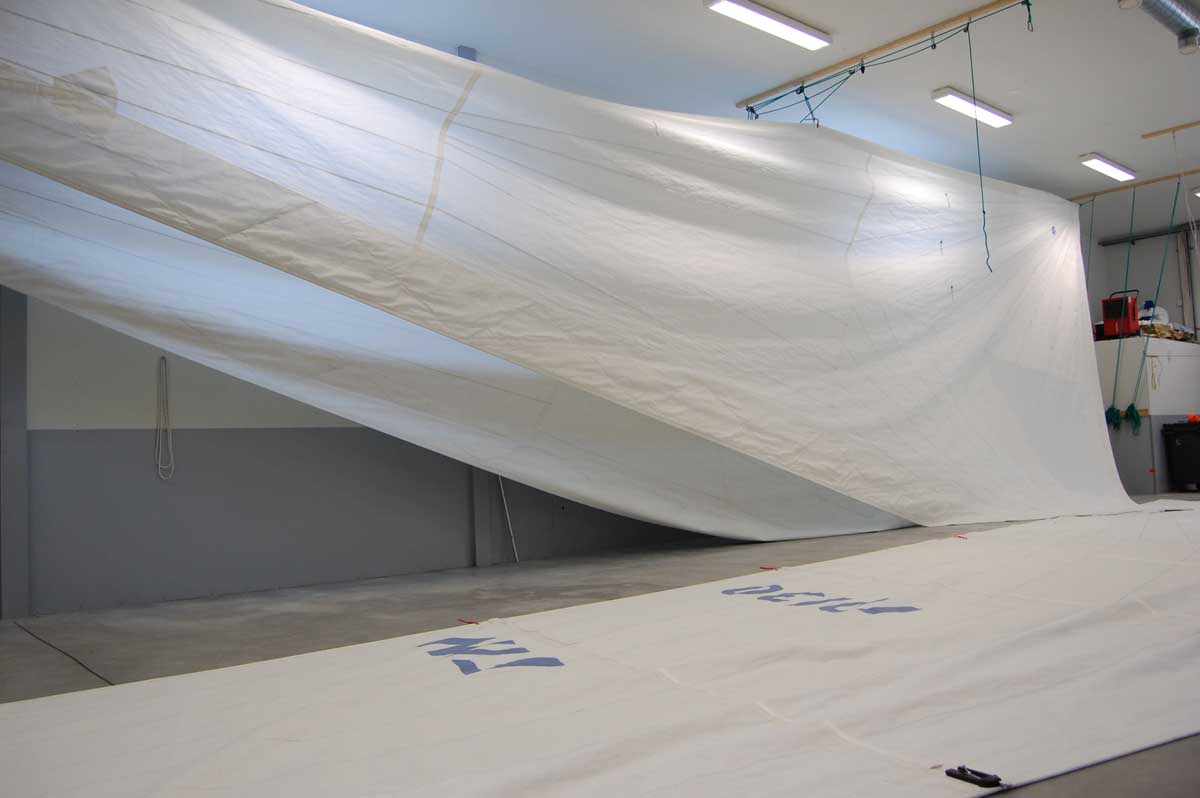
Ropes and cables
Boat ropes and cables should be washed with fresh water after every sail to remove salt and maintain their elastic, load and resistance properties.
The ropes are also among the main culprits for that salty smell that can often be smelled inside boats.
With spring, you may decide to do a slightly deeper wash to remove dirt and stains.
Ideally, the ropes should be soaked for several hours. A normal liquid fabric cleaner can be added to the fresh water.
For sheets and halyards, it is a good idea to do the final wash in the washing machine with hot water, detergent, bleach and, if desired, a little softener.

Anchor, chain and anchor winch
The anchor and its chain also need a good cleaning after some time to remove salt deposits and oxidation principles.
They should therefore be landed and rinsed with plenty of fresh water.
Also wash the anchor winch with a detergent and after drying it, lubricate the electrical contacts, controls and pulley.
Before putting everything away, also clean the anchor compartment and especially the vent to prevent water from stagnating.
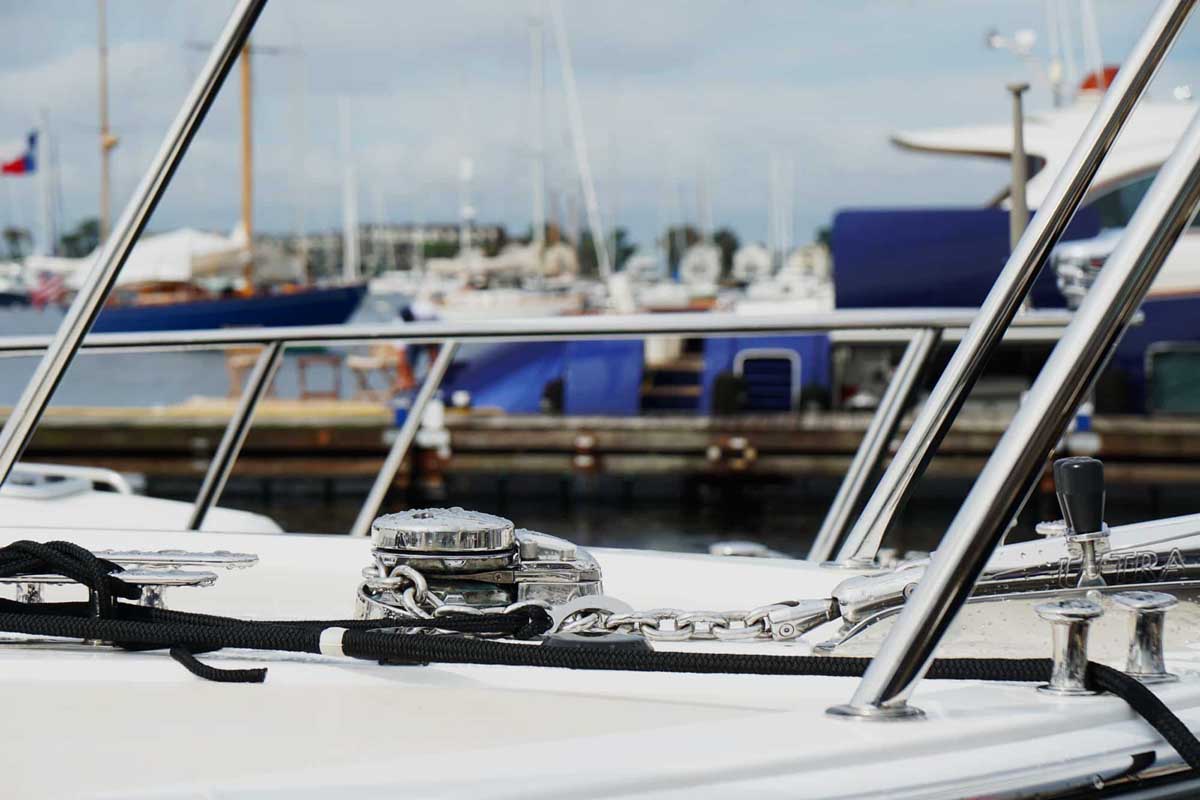
Inboard
Cleaning the inboard helps to ensure that there are no strange leaks, sagging, loose parts, as well as reducing the presence of unpleasant odours below deck.
Start at the top of the engine and brush the various parts with a hard-bristled brush soaked in a can of naphtha, or spray with Crc or WD-40 to remove old grease, traces of oil and dirt.
Particular care must be taken not to get wiring and electrical parts wet. Then dry the cleaned parts with a smooth cloth.
If the outboard is already a few years old, it may need a coat of paint. There are special acrylic paints on the market that not only give the engine a new 'look' but also restore the necessary resistance to salt and humidity to the cast iron and light alloy metal parts.
Bilge and engine compartment
Oil, grease, sand, fuel and acids collect in the bilge and become a source of bad smells. The bilge must therefore be dried and cleaned.
The same should be done with the through-mast compartment, as well as with the dunnage, which should be raised to thoroughly clean the areas underneath, especially the 'service' ones, for the log and sounder or those in the bathroom and galley that collect more dirt.
No less important is cleaning the inboard compartment, a hotbed of fuel residues, grease, oil, sludge, which make the air below deck unbreathable.
In addition to normal detergents, in this case it is also a good idea to use an emulsifier that, more or less diluted depending on the amount of dirt, is able to break the hydrocarbon chain, preventing it from rejoining.
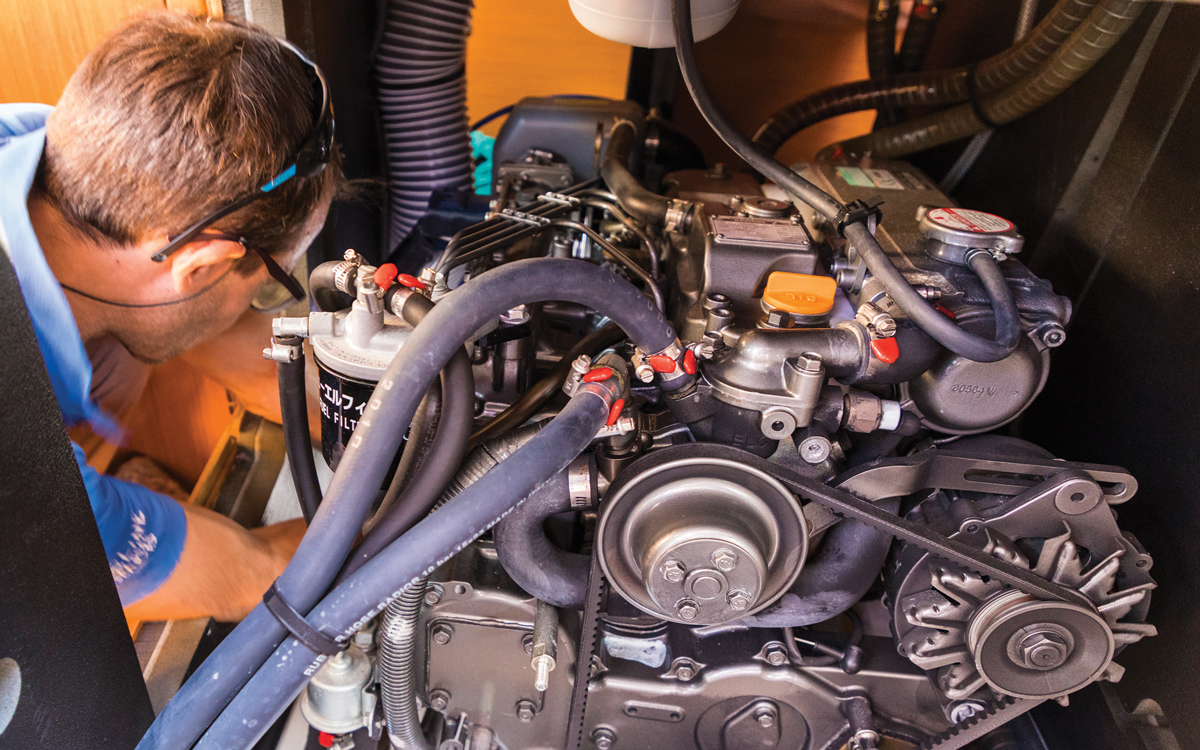
Cooker, oven and fridge
The kitchen should be removed from its housing and the back should be cleaned, after which the cooker should be dismantled in order to wash it and the hob thoroughly, then the oven should be descaled. A good clean should also be given to the fridge, as well as the icebox.
In addition to water, use bicarbonate of soda to eliminate unpleasant odours.
While on the gaskets it is good to pass a layer of Vaseline, then leave the doors open to let the air circulate.
Particular attention should be paid to the galley, where those foods that are usually left on board (sugar, salt, oil, vinegar) that are easily affected by moisture and mould should be checked. Even tins can develop corrosion principles that can make these compartments unhealthy. Moisture also attacks crockery, glasses and aluminium pots and pans.
It is therefore best to rinse everything with fresh water and dry well before storing them.
Bathroom
After the long winter break, the hydraulic circuit of the toilet should also be purged.
It is advisable to flush the system avoiding aggressive detergents for plastics and ceramics, such as bleach, and instead opting for neutral products or disinfectants.
Pumping a mixture of lukewarm water and white vinegar into the circuit and letting it stand for a couple of hours will also remove much of the limescale build-up.
It is important to remove the vinegar because it corrodes most metal alloys and membranes.
A mixture of light oil and water will instead keep the internal parts soft and lubricated.
Finally, should the pipes give off a bad smell, do not hesitate to replace them: there are also specific products on the market scented with various essences.
urniture, fittings and cabinets
Below deck, moisture and air stagnation are the main culprits of condensation and mould with inevitable unpleasant odours.
Cleaning cupboards, cabinets, cupboards and lockers helps to eliminate the smell of damp and saltiness, the stagnation of moisture and the spread of bacteria.
Start by opening and airing all these compartments to ventilate them and allow the wood to dry. Then one dusts, taking care to reach the most hidden corners, and moves on to washing, equipped with a bug, rag and soap.
If mould is present, a little chlorine or amuchina can be added to the water.
Wooden parts (drawers, doors, etc.) can be cleaned with specific products such as household oils and waxes.
Finally, it is important to dry everything well with absorbent cloths and leave to air.
Some objects such as waxes, books, nautical charts can be landed to be cleaned separately and get some air.

Fabrics, cushions and mattresses
If the upholstery fabrics are removable, remove and wash them, remembering to close the zip and Velcro first.
If the covers are fixed, wipe them with a clean damp cloth or revitalising products and then leave them to air dry.
Some antibacterial sprays are also indicated. Mattresses should be unpacked and kept in the air for a few hours to remove the accumulated moisture inside.
A good idea is to rinse everything at once - cushion covers, mattress covers, duvets, sheets, curtains, sail bags, awning, lazy bags, spray hoods - at the very least at home, using a delicate washing machine programme, cold, without detergents and avoiding the spin cycle. If soap is used, provide two rinses.
Finally, remember to spray lubricant on the hinges to prevent oxidation.
Tender
Washing extends the life of the dinghy.
It would be a good idea to use a soap specifically for dinghies, never household degreasers, which take away a layer of the fabric along with the dirt.
Just as important is not to put the detergent directly on the fabric, but on a cloth or sponge and rub it in evenly, first diluted in fresh water and more concentrated where the dirt is more stubborn.
Rinse everything and in particular the handkerchief selvedges.
After washing, if any stains persist, you can proceed with a cotton ball freshly moistened with nitro thinner.
After cleaning, you can proceed with waxing, otherwise the fabric will remain porous, get dirty more easily and be more exposed to the action of salt, UV rays, etc. There are various types of impregnating waxes on the market that soften the fabric of the dinghy, preventing it from cracking, and form an antibacterial and waterproof protective layer.
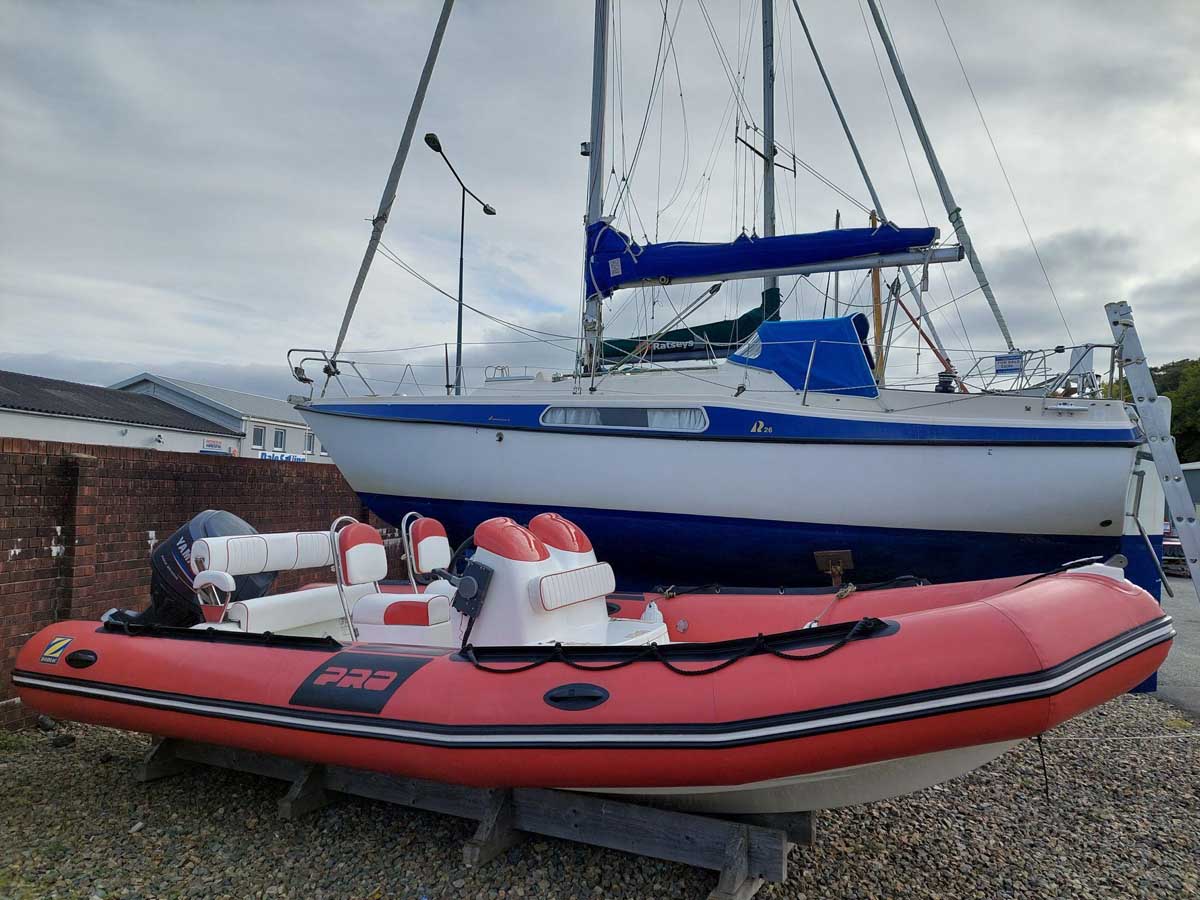
Outboard
Like all engines, the outboard needs some care, first and foremost a good cleaning.
The exterior should be rinsed with fresh water and a detergent to remove traces of grease and dirt.
To remove salt residues from the cooling circuit, on the other hand, you can immerse the foot in a drum of fresh water and let the engine run for half an hour. Before switching it off, then close the fuel tap and spray oil through the carburettor air intake. Internal parts such as throttle linkage, advance and inverter should also be cleaned and greased.
The tank should be emptied and the filters cleaned (or replaced if old).
Finally, external moving parts such as the hinges and tilt mechanism should be treated with water-repellent spray.
Finally, electrical parts should be sprayed with antioxidant liquid.
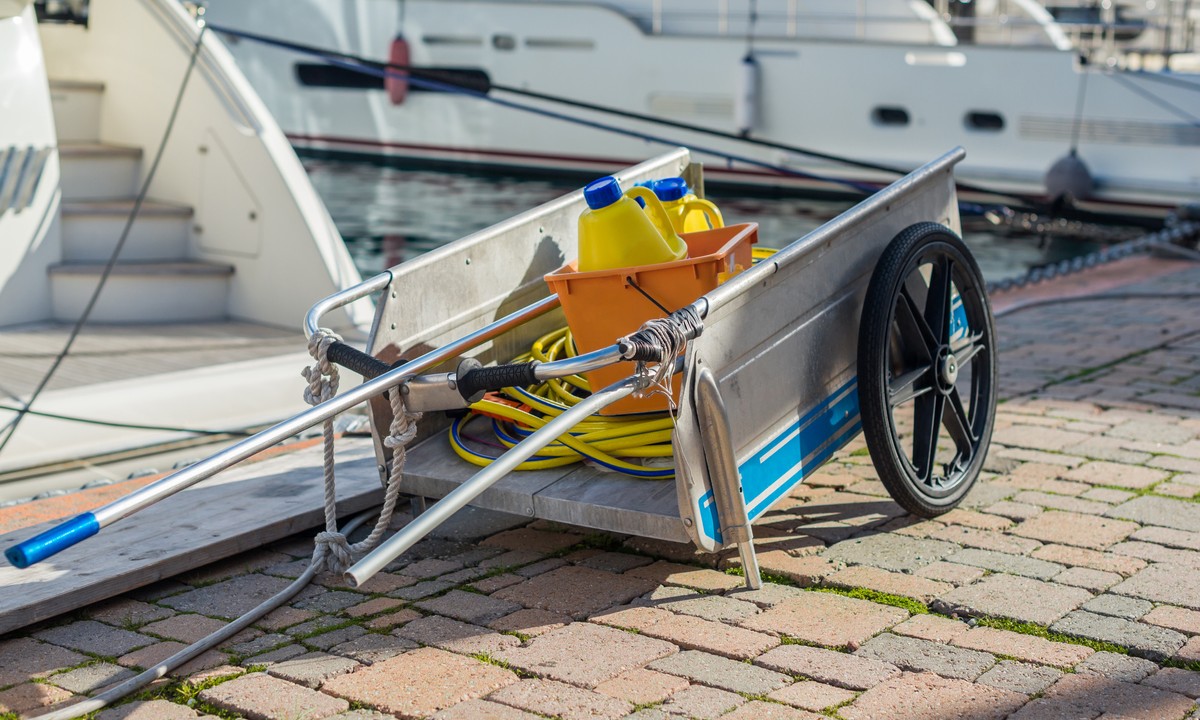
Taking care of every component in the boat, cleaning it and checking its perfect condition and functionality, means being a true sailor.
All this care is rewarded by the knowledge that you are on board a boat that is not only beautiful and pleasant, but also efficient and above all safe.
Happy sailing everyone!

